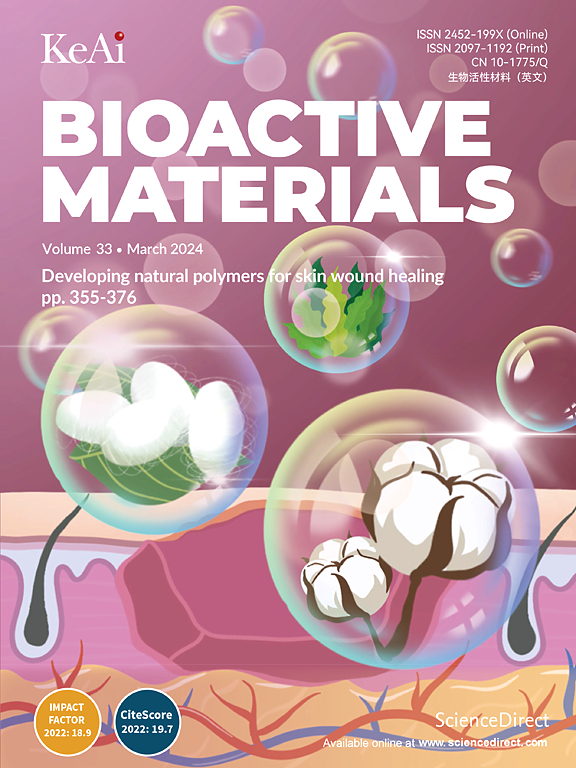口服益生菌细胞外囊泡治疗通过钝化IL-17信号通路减轻甲型流感病毒感染。
IF 18
1区 医学
Q1 ENGINEERING, BIOMEDICAL
引用次数: 0
摘要
甲型流感病毒(IAV)破坏呼吸道以外的肠粘膜组织。益生菌对维持肠道微生态系统的平衡和稳定起着至关重要的作用。来自益生菌的细胞外囊泡(EVs)已成为宿主免疫反应和抗炎作用的潜在介质。然而,益生菌衍生的ev对IAV的具体抗炎作用和潜在机制尚不清楚。在本研究中,我们研究了罗伊氏乳杆菌eha2衍生ev (lrev)对IAV感染小鼠模型的治疗效果。口服lrev分布于肝、肺和胃肠道。在感染IAV的小鼠中,口服lrev减轻了IAV引起的肺和肠损伤,改变了微生物群组成,并增加了这些器官中短链脂肪酸的水平。从机制上讲,lrev通过减弱促炎IL-17信号传导来发挥其对IAV感染的保护作用。此外,FISH分析在肺和肠组织中检测到miR-4239,这是lrev中最丰富的mirna之一。我们证实miR-4239直接靶向IL-17a。我们的发现为未来lrev在流感治疗中的应用奠定了基础,并为miR-4239的抗炎作用提供了新的机制见解。本文章由计算机程序翻译,如有差异,请以英文原文为准。

Oral probiotic extracellular vesicle therapy mitigates Influenza A Virus infection via blunting IL-17 signaling
The influenza A virus (IAV) damages intestinal mucosal tissues beyond the respiratory tract. Probiotics play a crucial role in maintaining the balance and stability of the intestinal microecosystem. Extracellular vesicles (EVs) derived from probiotics have emerged as potential mediators of host immune response and anti-inflammatory effect. However, the specific anti-inflammatory effects and underlying mechanisms of probiotics-derived EVs on IAV remain unclear. In the present study, we investigated the therapeutic efficacy of Lactobacillus reuteri EHA2-derived EVs (LrEVs) in a mouse model of IAV infection. Oral LrEVs were distributed in the liver, lungs, and gastrointestinal tract. In mice infected with IAV, oral LrEVs administration alleviated IAV-induced damages in the lungs and intestines, modified the microbiota compositions, and increased the levels of short-chain fatty acids in those organs. Mechanistically, LrEVs exerted their protective effects against IAV infection by blunting the pro-inflammatory IL-17 signaling. Furthermore, FISH analysis detected miR-4239, one of the most abundant miRNAs in LrEVs, in both lung and intestinal tissues. We confirmed that miR-4239 directly targets IL-17a. Our findings paved the ground for future application of LrEVs in influenza treatment and offered new mechanistic insights regarding the anti-inflammatory role of miR-4239.
求助全文
通过发布文献求助,成功后即可免费获取论文全文。
去求助
来源期刊

Bioactive Materials
Biochemistry, Genetics and Molecular Biology-Biotechnology
CiteScore
28.00
自引率
6.30%
发文量
436
审稿时长
20 days
期刊介绍:
Bioactive Materials is a peer-reviewed research publication that focuses on advancements in bioactive materials. The journal accepts research papers, reviews, and rapid communications in the field of next-generation biomaterials that interact with cells, tissues, and organs in various living organisms.
The primary goal of Bioactive Materials is to promote the science and engineering of biomaterials that exhibit adaptiveness to the biological environment. These materials are specifically designed to stimulate or direct appropriate cell and tissue responses or regulate interactions with microorganisms.
The journal covers a wide range of bioactive materials, including those that are engineered or designed in terms of their physical form (e.g. particulate, fiber), topology (e.g. porosity, surface roughness), or dimensions (ranging from macro to nano-scales). Contributions are sought from the following categories of bioactive materials:
Bioactive metals and alloys
Bioactive inorganics: ceramics, glasses, and carbon-based materials
Bioactive polymers and gels
Bioactive materials derived from natural sources
Bioactive composites
These materials find applications in human and veterinary medicine, such as implants, tissue engineering scaffolds, cell/drug/gene carriers, as well as imaging and sensing devices.
 求助内容:
求助内容: 应助结果提醒方式:
应助结果提醒方式:


